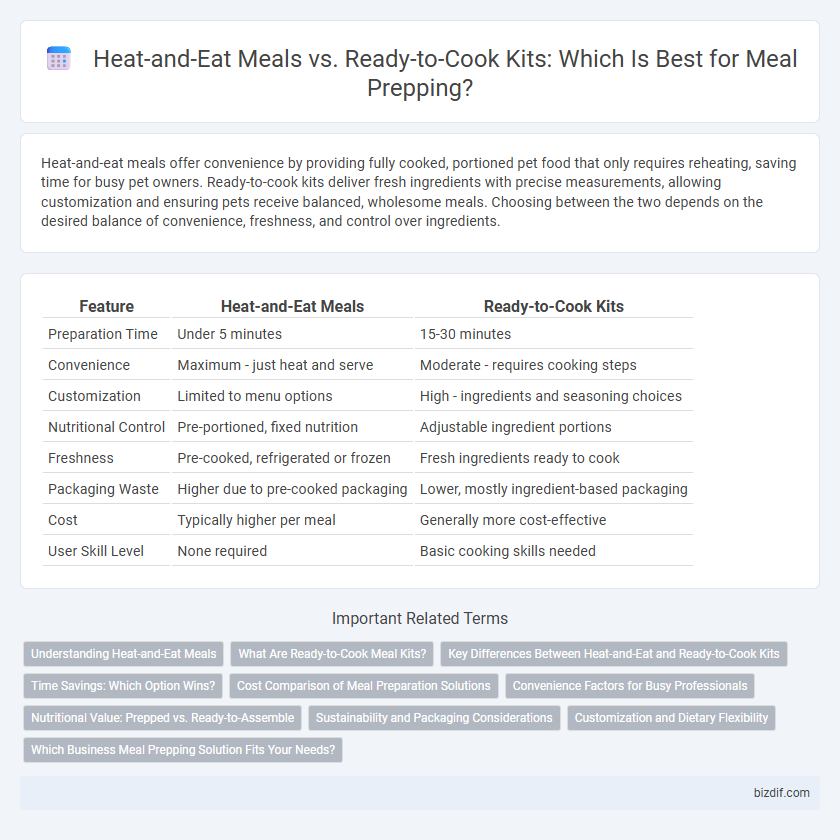Heat-and-eat meals offer convenience by providing fully cooked, portioned pet food that only requires reheating, saving time for busy pet owners. Ready-to-cook kits deliver fresh ingredients with precise measurements, allowing customization and ensuring pets receive balanced, wholesome meals. Choosing between the two depends on the desired balance of convenience, freshness, and control over ingredients.
Table of Comparison
| Feature | Heat-and-Eat Meals | Ready-to-Cook Kits |
|---|---|---|
| Preparation Time | Under 5 minutes | 15-30 minutes |
| Convenience | Maximum - just heat and serve | Moderate - requires cooking steps |
| Customization | Limited to menu options | High - ingredients and seasoning choices |
| Nutritional Control | Pre-portioned, fixed nutrition | Adjustable ingredient portions |
| Freshness | Pre-cooked, refrigerated or frozen | Fresh ingredients ready to cook |
| Packaging Waste | Higher due to pre-cooked packaging | Lower, mostly ingredient-based packaging |
| Cost | Typically higher per meal | Generally more cost-effective |
| User Skill Level | None required | Basic cooking skills needed |
Understanding Heat-and-Eat Meals
Heat-and-eat meals offer convenience by providing fully cooked dishes that only require reheating, making them ideal for busy individuals and quick meal solutions. These meals often come pre-portioned with balanced nutrition, saving time while maintaining dietary goals. Understanding the shelf life and ingredient quality is crucial for selecting heat-and-eat options that align with health and taste preferences.
What Are Ready-to-Cook Meal Kits?
Ready-to-cook meal kits provide pre-portioned ingredients and step-by-step recipes, allowing users to prepare fresh meals at home with minimal effort. These kits often include vegetables, proteins, and spices, ensuring balanced nutrition and reducing food waste by providing just the right amounts. Unlike heat-and-eat meals, ready-to-cook kits involve a hands-on cooking experience that enhances flavor and customization options.
Key Differences Between Heat-and-Eat and Ready-to-Cook Kits
Heat-and-eat meals offer the convenience of fully prepared dishes that require only reheating, making them ideal for quick consumption and minimal kitchen effort. Ready-to-cook kits provide pre-measured ingredients and step-by-step instructions, allowing for fresh cooking with greater control over taste and customization. Nutritional value varies, with heat-and-eat meals often having higher preservatives, while ready-to-cook kits promote fresher ingredients and potentially healthier options.
Time Savings: Which Option Wins?
Heat-and-eat meals offer the fastest time savings, typically requiring only a few minutes in the microwave or oven, making them ideal for busy schedules. Ready-to-cook kits save time by providing pre-measured ingredients and step-by-step recipes, but still need 20 to 40 minutes for preparation and cooking. For individuals prioritizing maximum time efficiency, heat-and-eat meals consistently outperform ready-to-cook kits in reducing overall meal preparation time.
Cost Comparison of Meal Preparation Solutions
Heat-and-eat meals typically cost more per serving due to convenience factors and longer shelf life, averaging $6 to $10, whereas ready-to-cook kits generally range from $4 to $8, offering fresh ingredients with some preparation required. Ready-to-cook kits often reduce grocery expenses by providing pre-portioned ingredients, minimizing food waste compared to purchasing individual items for heat-and-eat options. Budget-conscious consumers find ready-to-cook kits more economical for regular meal preparation, while heat-and-eat meals serve better for quick, occasional use despite higher costs.
Convenience Factors for Busy Professionals
Heat-and-eat meals offer unmatched convenience for busy professionals by saving valuable time on both cooking and cleaning, requiring only reheating in a microwave or oven. Ready-to-cook kits provide fresh ingredients with pre-measured portions and easy-to-follow recipes, balancing convenience with the satisfaction of homemade meals. Both options reduce meal preparation stress, but heat-and-eat products excel in speed, while ready-to-cook kits engage users who want quick cooking without extensive prep work.
Nutritional Value: Prepped vs. Ready-to-Assemble
Heat-and-eat meals offer convenience but often contain higher sodium and preservatives that can reduce nutritional quality compared to ready-to-cook kits. Ready-to-cook kits provide fresh ingredients and customizable portions, preserving more vitamins, minerals, and allowing for healthier meal control. Nutritional value tends to be superior in ready-to-assemble options due to minimal processing and ingredient transparency.
Sustainability and Packaging Considerations
Heat-and-eat meals often rely on single-use plastic containers that contribute to landfill waste and pose challenges for recycling infrastructure. Ready-to-cook kits typically use a combination of recyclables and compostable materials, reducing overall environmental impact by minimizing food waste through portion control. Choosing kits with biodegradable packaging or guaranteed recyclable certifications supports sustainable meal prepping practices and lowers carbon footprints.
Customization and Dietary Flexibility
Heat-and-eat meals offer convenience but often lack customization and dietary flexibility compared to ready-to-cook kits. Ready-to-cook kits provide tailored ingredient choices that accommodate specific dietary needs such as keto, vegan, gluten-free, or low-carb diets. Consumers seeking personalized nutrition and ingredient control benefit more from ready-to-cook options than from pre-prepared heat-and-eat meals.
Which Business Meal Prepping Solution Fits Your Needs?
Heat-and-eat meals offer convenience with fully cooked dishes requiring minimal preparation, ideal for busy professionals seeking quick nutrition. Ready-to-cook kits provide fresh ingredients and customizable recipes, catering to those who enjoy cooking but want to save time on shopping and meal planning. Assess your schedule, cooking skills, and dietary preferences to determine whether the simplicity of heat-and-eat or the flexibility of ready-to-cook kits best aligns with your business meal prepping needs.
Heat-and-eat meals vs Ready-to-cook kits Infographic

 bizdif.com
bizdif.com